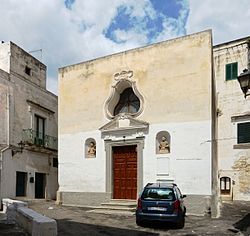Grottaglie
Grottaglie is a town and comune in the province of Taranto, Apulia, in southern Italy.
Grottaglie
li Vurtàgghie (Sicilian) | |
|---|---|
| Comune di Grottaglie | |
 Church of Madonna del Lume. | |
| Coordinates: 40°32′N 17°26′E / 40.533°N 17.433°E | |
| Country | Italy |
| Region | Apulia |
| Province | Taranto (TA) |
| Frazioni | Carraro delle Vacche, Paparazio |
| Government | |
| • Mayor | Ciro D'Alò (Lista civica Grottaglie ON) |
| Area | |
| • Total | 102.12 km2 (39.43 sq mi) |
| Elevation | 133 m (436 ft) |
| Population (December 31 2014)[2] | |
| • Total | 32,114 |
| • Density | 310/km2 (810/sq mi) |
| Demonym | Grottagliesi |
| Time zone | UTC+1 (CET) |
| • Summer (DST) | UTC+2 (CEST) |
| Postal code | 74023 |
| Dialing code | 099 |
| Patron saint | St. Francis of Geronimo, St. Cyrus |
| Saint day | January 31 |
| Website | Official website |
Geography
changeGrottaglie is in the Salento peninsula, a whole rock of Limestone dividing Adriatic Sea from Ionian Sea. The countryside around the city has many large and deep ravines.
History
changeThe name Grottaglie comes from the Latin Cryptae Aliae, meaning "many ravines". People lived here since the paleolithic Age. The fief of Grottaglie was given by the Norman overlords to the Archdiocese of Taranto in the 11th century. In the 14th century the church gave the fief a walls and a castle.
Since the 15th-17th centuries the jurisdiction over Grottaglie fief was split between the ecclesiastic administration (civil law) and the lay feudal lords (criminal law, Cicinelli-Caracciolo family). Fights between these two competing authorities and revolts by the heavily-taxed population were common until the end of feudalism (1806).
Main sights
change- The massive Castello Episcopio (13th century) castle.
- The main church, also known as Chiesa Matrice, dating back to 1379.
- The city's oratory, known as Purgatory Oratory.
- Palazzo Cicinelli, a massive building on the main square later redecoreted to the current fashion during the Baroque period. The palazzo was the seat of the Duke of Grottaglie also Prince of Cursi and Princes of the Holy Roman Empire, hence the residence of the feudal lords of the town on the grant of Bohemo.
- Palazzo Urselli, which maintains the original Renaissance (pre-Baroque) façade, with a massive 15th century gate and a decorated internal courtyard.
- Palazzo Maggiulli-Cometa, whose structure is similar to Palazzo Urselli’s.
- Palazzo De Felice, an 18th Century palace, and ancestral home of the De Felice's family.
- Monastero di Francesco di Paola, representing the greatest Baroque monument in the city. It has a splendid cloistered-court inside.
- Chiesa del Carmine, housing a 1530 stone crib scene made by Stefano da Putignano.
Culture
changeFolkloristic and religious events include the commemoration-day of Ciro di Alessandria d'Egitto and Easter-period when the Medieval-rooted confraternal religious orders perform their processions during the days of the Holy Week (Easter rituals include Procession and pilgrimage of confrères called “Bubble-Bubble” through the streets of town).
Other events include:
- The exhibition “Ceramica nel Quartiere delle Ceramiche”
- The Mediterranean ceramics contest, theatrical and musical events
- Promotion of dessert grapes, months of July–August–September
- Exhibition-contest about ceramic crib scene during the months of December and January
- “Musica Mundi” – international festival of ethnic music in July.
Economy
changeGrapes and ceramics are two main elements of the local economy.
Alenia Composite is a factory of Alenia group making parts for the Boeing 787.
References
change- ↑ "Superficie di Comuni Province e Regioni italiane al 9 ottobre 2011". Italian National Institute of Statistics. Retrieved 16 March 2019.
- ↑ "Popolazione Residente al 1° Gennaio 2018". Italian National Institute of Statistics. Retrieved 16 March 2019.



